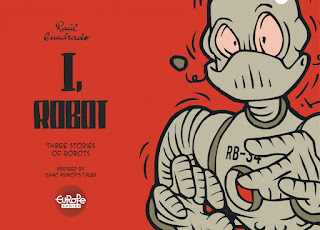I, Robot by Raúl Cuadrado
Three of Asimov’s tales illustrating these principles are adapted for this graphic novel by Raúl Cuadrado, the stories linked, as they were when first collected as I, Robot, by a framework that puts them in the context of the reminiscences of Dr Susan Calvin in the year 2057. She relates to a reporter some of the unique early encounters with the peculiarities of robot technology and ‘robopsychology’ that helped establish these important rules rules to understand and control the development of robots.
In Rotating Direction, Greg Powell and Mike Donovan encounter a problem on Mercury with their robot. Speedy has been sent out on surface to collect Selenium from a well of an abandoned mine to recharge the photocell barrier that will protect them from frying in this environment, but Speedy has quite literally fallen into a logic loop. He can’t follow the three orders because the emanation of carbon monoxide will cause corrosion and poses a risk to the robot’s own integrity. That is resolved here when Greg risks his own life, hoping that Speedy will place more importance on the first law than the third.
The second story Robbie looks at the question of humans developing an emotional attachment to robots, the possibility that robots might even develop an emotional attachment to humans, and it explores whether there might be dangers in this. Because of her father’s work, a young girl Gloria is able to spends all her time playing with a robot called Robbie, who is a playmate and protector. Her mother isn’t happy with this unnatural attachment that Gloria has with Robbie and eventually the robot is replaced by a dog. They hope that Gloria will grow out of this when she understands that Robbie is just a common mechanical object, but the bond goes deeper than that.
As the title indicates, Liar considers the situation where a robot could lie in order to “protect” humans. Ashe, a robotics engineer working on a R8-34 model “Herbie” believes that the robot is able to read his mind and hold a mental conversation with him. It should be impossible but a potentially worrying development if it turns out to be true in any way. Or perhaps even a useful one since it appears that humans aren’t always able to read each other or even their own deepest feelings. Herbie might be able to provide some insight and reassurances to their personal and professional concerns, but can he be trusted with complex feelings that go beyond logic and reason?
An outline description makes the stories of I, Robot sound rather ‘academic’ in how they consider very serious logic and reasoning matters involving technology, but Azimov makes them highly entertaining, and likewise Raúl Cuadrado in this adaptation. The colour scheme of sepia tones with bold reds is attractive and suits the retro futuristic style of the artwork’s cartoony treatment of the science fiction material. There’s a good balance of dialogue and visual storytelling that effectively condenses the narrative, with some well-illustrated scenes such as when Gloria and her family visit New York in Robbie. The half-page landscape format works well in the ebook medium, particularly on a widescreen laptop where you can see and read a whole page.
I, Robot, Three Stories of Robots inspired by Isaac Asimov’s tales by Raúl Cuadrado is published in eBook format in English by Europe Comics.







Comments
Post a Comment